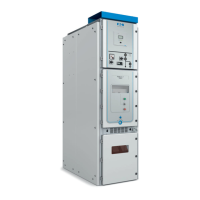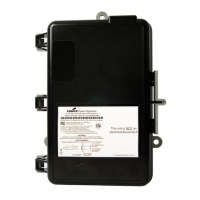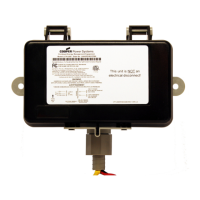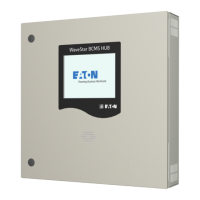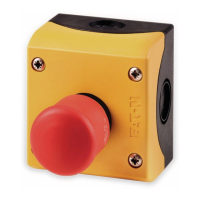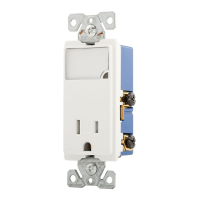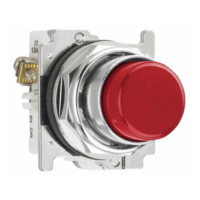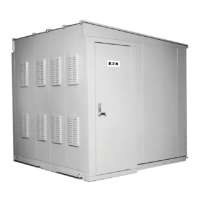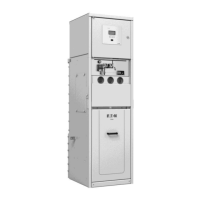9
Instruction Manual IM01500001E
Effective July 2011
Pow-R-Line switchboards
EATON CORPORATION www.eaton.com
Electrical connection of
switchboard sections
Several methods may be used to make electrical connections within
switchboards. More than one of these methods may be used in a
section and/or switchboard lineup. These include bus splice plates,
factory-installed cable, and busway connections. Consult the manu-
facturer’s drawings for details for each switchboard section.
Remove structure deadfront covers and side sheets as needed
to access switchboard chassis and components. Retain all cover
mounting hardware and covers for re-assembly. Protect hardware
and parts from moisture, debris, and damage.
Splice Plates
Splice plates are short pieces of busbar that join the main bus run-
ning horizontally through multiple section switchboards. Depending
on the configuration and alignment of the switchboard, the splice
plates used for the main cross bus may vary. These plates may
either be flat or “Z” shaped. (See Figure 16 and Figure 17.)
Figure 16. Splice Plates
For larger amperage switchboards, multiple splice plates are to be
used on the same phase. Maintain the orientation, by phase and
sequence of the splice plates. The orientation of the splice plates
must remain identical to the way they were shipped from the
manufacturer. Clearances must be maintained. If unsure about
the correct orientation or there are questions about the installation,
contact Eaton before installing the splice plates.
Figure 17. Spacer Locations Between Splice Plates
(Typical for All Widths)
Splice plates are used to attach the main horizontal bus between
switchboard sections or shipping splits. While maintaining the cor-
rect phase orientation and sequence, install splice plates with the
carriage bolts and hex nuts with captive Belleville washers supplied
by the manufacturer. Refer to Appendix A, Table 2 for torque values.
Carriage bolts must align with the corresponding rectangular holes
in the fixed horizontal bus and the splice plates. If multiple splice
plates are used, install in the same sequence as shipped from the
manufacturer. The neutral (when furnished) and ground bus should
be connected in the same manner.
Inspect splices plates and main fixed horizontal bus prior to
installation. If there is any suspected damage, contact the manu-
facturer immediately for replacements. NEVER ENERGIZE ANY
SWITCHBOARD WITH DAMAGED BUS OR COMPONENTS.
To accommodate future serviceability, the manufacturer recom-
mends that the head of the carriage bolt be mounted from the rear
of the switchboard for FRONT ACCESSIBLE switchboards with the
hex nut with Belleville washer positioned to the front.
For REAR ACCESSIBLE switchboards, the manufacturer recom-
mends that the head of the carriage bolt be mounted from the front
of the switchboard with the hex nut and Belleville washer positioned
to the rear.
Repeat the process until all holes in the horizontal bus are connected
with bolts and nuts for each shipping split. Inspect connections to
ensure that there is no foreign material at the connection point and
that all connections are properly aligned and bolts are seated.
Torque all connections to torque requirements on labels affixed to
each switchboard and as shown in Appendix A, Table 2.
View "A"
Typical View When More
Than One Bar Per Phase
Spacer

